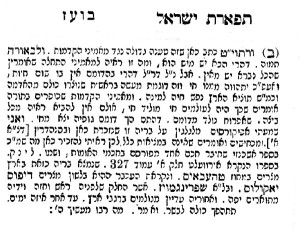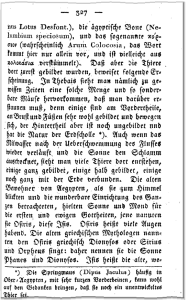B”H
Yud Alef Nissan 5774
April 11, 2014
Please enjoy some points of the last shiur accompanied by links to interesting reading material.
Chag Kosher ve’Sameach to all!
Ari
—————–
While discussing the prohibition to rebuild Yericho (Jericho), Sanhedrin 113a, we mentioned the prohibition to live in Egypt – Mitzrayim.
כתב הרמב”ם:
“ומותר לשכון בכל העולם חוץ מארץ מצרים מן הים הגדול ועד המערב ארבע מאות פרסה על ארבע מאות פרסה כנגד כוש וכנגד המדבר, הכל אסור להתישב בה. בשלושה מקומות הזהירה תורה שלא לשוב מצרים שנאמר ‘לא תוסיפון לשוב בדרך הזה עוד’, ‘לא תוסיף עוד לראותה’, ‘לא תוסיפו לראותם עד עולם’, ואלכסנדריאה בכלל האיסור”
(משנה תורה, הלכות מלכים פרק ה’ הלכה ז’).
It is a topic that much has been written about – primarily as to why historically, despite the prohibition, one finds Jews – amongst them the Rambam no less – that did indeed live in Egypt.
Many explanations are offered. Here are some:
1- The prohibition was only temporary. G-D didn’t want Jews, soon after the exodus, returning to the awful place they had left from.
2- Only if one travels to Egypt using the exact route the Jews took at yetzias Mitzrayim. Not if one arrives via the sea for example.
3- One is allowed to live there temporarily for the sake of earning a living.
4- Assyrian King Sancheriv, upon conquering many lands, exiled every homogenous population and relocated them to another country. He did so to the Jews too – “the exile of the ten tribes.” The intention of the Biblical prohibition not to return to mitzrayim was so as not to mingle and learn from the abominable original Egyptians. The Egyptian population since the reign of Sancheriv are newcomers. Thus the prohibition is null and void.
See לקו”ש יט. שופטים ב. ע 171.
5- The Halacha only applies in a time when Jew are שרויין על אדמתם” (See Ritva, Yuma 38A) (If so, if you are a real zionist there might be a problem specifically today to live in Egypt. See Tzitz Eliezer Chelek 14 Siman 87 Seif 7 )
6- Where the Rambam lived is not מצרים proper.
7- Radvaz- Prohibition is only if upon entry to מצרים the intention was to stay forever. It does not apply if the original purpose was only for a visit.
—————————
We mentioned the famous quote from the ancient Jewish traveler Rabbi Ishtori Haparchi.
No – he was not Oriental…..
See his bio here: http://en.wikipedia.org/wiki/Ishtori_Haparchi
In Hebrew: http://he.wikipedia.org/wiki/%D7%90%D7%A9%D7%AA%D7%95%D7%A8%D7%99_%D7%94%D7%A4%D7%A8%D7%97%D7%99
His book: Kaftor vo’Ferach is a travelogue of Eretz Yisroel composed in the 13th century!
One printing: http://www.hebrewbooks.org/15272
It is indeed a very interesting read.
In any case, Reb Ishtori (or Ish Tori), writes that upon his visit to Cairo he met a great grandson of the Rambam. The descendant tells him his great grandfather would alway sign his letters:
“Moshe son of Maimon – he who daily transgresses three Lavim (prohibitions)”
Wow!
The problem is that many say the Rambam never penned such words. Why?
Firstly, it does not make sense that the Rambam, who clearly states in his Yad that the prohibition still exists, would write that on himself. Surely the Rambam had a valid Halachic reason for remaining in Mitzrayim and would therefore not be transgressing these Lavs.
The Rambam in the Yad only writes exception # 3 above. Perhaps he felt that, after being exiled from Spain, Egypt was the only place to survive as a Jew make a living.
Secondly, and recent finds of manuscripts support this, we have in our possession some actual letters written by the Rambam and this “alleged” subscript is nowhere to be found.
וראה שדי חמד ג, מ”ע י, מו
——————-
We mentioned a Kabbalistic answer. Here it goes:
The world was created with holy sparks sprinkled over the entire globe. The goal of Yiden is to find these lost sparks and elevate them by transforming each one with deeds of Torah and Mitzvos.
Creation began with 288 sparks. Moshiach will come when we find and elevate 100% of these wandering sparks.
When Jews left Mitzrayim they “emptied” that land of all “spark of Kedusha”. Thus, there was no need to be in Egypt any longer. Therefore a prohibition existed for Jews to return there as there was nothing for him to accomplish in Mitzrayim.
This idea is dealt at length in several of the Arizal’s works. See here from the Pri Etz Chaim written by Reb Chaim Vital:
http://beta.hebrewbooks.org/pdfpager.aspx?req=49521&st=&pgnum=67
Actually, that generation elevated 202 sparks out of the 288.
The words “and also the eirev rav exited with them (Jews)” וגם ערב רב עלה עמהם allude to the 202 (rav) that were purified.
This concept is mentioned by the Alter Rebbe in Torah Or, Parshas Bo. 120.
See also
כנפי יונה ח”ג סנ”ו. הובא במגלה עמוקות אופן נח. תו”א בא ס, ג. סה”מ תרפ”ט ע’ 205. וש”נ.
תו”ח בא ח”א קטו, סע”ב.
——————
Parenthetically, we have been trying hard to wrap up the measly balance of just 86 sparks…..
Question of the Alter Rebbe in Torah Or. וישב כז, ד.
There is an explanation from the Rebbe as to why millions of Jews since 2448 can’t seem to accomplish in over 3,000 years what 600,000 did in a mere 210 years…… But that’s another topic for the future. Bl”n.
———————–
Now the Arizal adds the clincher.
Unfortunately Jews transgressed this prohibition and returned to live in Mitzrayim. By doing this they “brought (back) unfiltered sparks”. ניצוצות שעדיין לא נתבררו
Egypt received new ‘lost sparks’ waiting to be transformed into Kedusha.
Consequently there currently is no prohibition to go back to Mitzrayim as there are lost sparks that need to be elevated.
This latter point is mentioned in the name of the Ariza”l by the Chido on Yuma 39,a.
See here:.
http://beta.hebrewbooks.org/pdfpager.aspx?req=40654&st=&pgnum=281
We have a Kabalistic answer concerning the Rambam and others who lived in Egypt.
[See here vort of the Besh”t that any Jew even when he arrives somewhere due to being lost! “clears the air” of Chutz Lo’Oretz. And he adds that this cleansing is accomplished via a Jew’s simple faith. Emuna Peshuta and even if this Emuna is currently asleep within him.
http://beta.hebrewbooks.org/pdfpager.aspx?req=14963&st=&pgnum=669]
——————
Today is Yud Alef Nissan so what follows is quite appropriate. The Rebbe mentioned the above explanation (why the Rambam et al did live in Egypt) in 1954 and again in 1974. (See both links below)
But all he said in 1954 was “as we find written” and in 1974 he added as it is in the “the writings of the Arizal”.
When they wrote the Sicha the world was turned over to find the exact location in the vast writings of the Arizal. (The Arizal didn’t write anything on his own. It was his students, primarily Reb Chaim Vital, who wrote what we know today as ‘Kabolas ho’Arizal”).
But alas! It was nowhere to be found. The Sicho in 1974 was printed without a footnote.
http://chabadlibrarybooks.com/pdfpager.aspx?req=4610&st=&pgnum=453&hilite
Enter the computer age….it was only in the last decade when searches were developed that it was located in the Chido’s writings in the name of the Arizal. A footnote was subsequently added.
דבש לפי מערכת ב, י. פתח עיניים יומא לח, א. ברכ”י אה”ע ד.
העו”ב תתצד ע’ 17.
———————-
Here is a spooky related item.
The previous Rebbe said in 1933 that the Maggid of Mezritch gave his students particular “Yechudim” for every country except for Germany! No explanation was offered.
http://www.lahak.org/pdf2/Reshimos/162.pdf
In 1954, the Rebbe recounted that 1933 Sicha. He added that for years people wondered “what is wrong with Germany?…..until after WWII it was unclear as to the German exception.150 years have passed since the Magid… it is finally understood…… “
He continued saying that nowadays one can say that even in Germany there is ‘work’ to do. The Rebbe paralleled this change to the prohibition concerning the return to Mitzrayim. That rule has changed due to the fact that Jews were exiled there and brought with them Nitzozos that need to be found and elevated. Etc.
See here the 1954 Sicha – lost sparks in Egypt and Germany. Pages 256-257:
http://www.chabadlibrary.org/books/default.aspx?furl=/admur/tm/10/27/257
See here (again) the 1974 Sicha for a slightly different idea.
http://chabadlibrarybooks.com/pdfpager.aspx?req=4610&st=&pgnum=453&hilite
Here the Rebbe says that it was gentiles that brought back these spark.
In Likutei Sichos Vol. 19, footnotes on page 171 there are references to several ‘Nigle’ ideas about these topic. See above #1-4.
http://beta.hebrewbooks.org/pdfpager.aspx?req=14942&st=&pgnum=184
See here a general overview in Hebrew. The Chido is mentioned on Page 9:
http://download.swdaf.com/DafDocs/succah/succah051_Living_in_Mitzrayim.pdf

